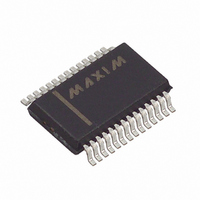MAX1401EAI+ Maxim Integrated Products, MAX1401EAI+ Datasheet - Page 29

MAX1401EAI+
Manufacturer Part Number
MAX1401EAI+
Description
IC ADC 18BIT LP 28-SSOP
Manufacturer
Maxim Integrated Products
Datasheet
1.MAX1401EAI.pdf
(36 pages)
Specifications of MAX1401EAI+
Number Of Bits
18
Sampling Rate (per Second)
480
Data Interface
QSPI™, Serial, SPI™
Number Of Converters
1
Power Dissipation (max)
750µW
Voltage Supply Source
Analog and Digital
Operating Temperature
-40°C ~ 85°C
Mounting Type
Surface Mount
Package / Case
28-SSOP
Number Of Adc Inputs
5
Architecture
Delta-Sigma
Conversion Rate
4.8 KSPs
Resolution
18 bit
Input Type
Voltage
Interface Type
Serial
Voltage Reference
External
Supply Voltage (max)
3 V
Maximum Power Dissipation
21.45 mW
Maximum Operating Temperature
+ 85 C
Mounting Style
SMD/SMT
Input Signal Type
Pseudo-Differential, Differential
Minimum Operating Temperature
- 40 C
Lead Free Status / RoHS Status
Lead free / RoHS Compliant
The on-chip digital filter processes the 1-bit data
stream from the modulator using a SINC
ter. The SINC filters are conceptually simple, efficient,
and extremely flexible, especially where variable reso-
lution and data rates are required. Also, the filter notch
positions are easily controlled, since they are directly
related to the output data rate (1 / data word period).
The SINC
while retaining the same frequency response notches
as the default SINC
faster at the expense of resolution and quantization
noise. The SINC
With 60Hz notches (60Hz data rate), the settling time
would be 1 / 60Hz or 16.7ms, whereas the SINC
would settle in 3 / 60Hz or 50ms. Toggle between these
filter responses using the FAST bit in the global setup
register. Use SINC
to SINC
from the SINC
bit low. The DRDY signal will go false and will be
reasserted when valid data is available, a minimum of
three data-word periods later.
The digital filter can be bypassed by setting the MDOUT
bit in the global setup register. When MDOUT = 1, the
raw output of the modulator is directly available at
DOUT.
The MAX1401 digital filter implements both a SINC
(sinx/x) and SINC
transfer function for the SINC
cascaded SINC
and in the frequency domain by:
where N, the decimation factor, is the ratio of the modu-
lator frequency f
3
1
mode when full accuracy is required. Switch
function results in a faster settling response
H(f)
1
1
H(z)
M
1
to SINC
filters described in the z-domain by:
3
filter settles in one data word period.
to the output frequency f
______________________________________________________________________________________
1
(sinx/x)
=
3
mode for faster settling, and switch
filter. This allows the filter to settle
=
N
1
3
+3V, 18-Bit, Low-Power, Multichannel,
⋅
N
1
mode by resetting the FAST
3
⋅
sin N
Filter Characteristics
sin
lowpass filter function. The
1 z
1 z
−
3
−
function is that of three
π
π
−
−
f
N
1
M
f
f
M
f
Oversampling (Sigma-Delta) ADC
3
Digital Filter
3
3
N
or SINC
.
3
1
filter
fil-
1
Figure 10 shows the filter frequency response. The
SINC
first notch frequency. This results in a cutoff frequency
of 15.72Hz for a first filter notch frequency of 60Hz. The
response shown in Figure 10 is repeated at either side
of the digital filter’s sample frequency (f
side of the related harmonics (2f
The response of the SINC
SINC
The output data rate for the digital filter corresponds
with the positioning of the first notch of the filter’s fre-
quency response. Therefore, for the plot of Figure 10
where the first notch of the filter is at 60Hz, the output
data rate is 60Hz. The notches of this (sinx/x)
repeated at multiples of the first notch frequency. The
SINC
100dB at these notches.
Determine the cutoff frequency of the digital filter by the
value loaded into CLK, X2CLK, MF1, MF0, FS1, and
FS0 in the global setup register. Programming a differ-
ent cutoff frequency with FS0 and FS1 does not alter
the profile of the filter response; it changes the frequen-
cy of the notches. For example, Figure 11 shows a cut-
off frequency of 13.1Hz and a first notch frequency of
50Hz.
For step changes at the input, a settling time must be
allowed before valid data can be read. The settling time
depends upon the output data rate chosen for the filter.
The settling time of the SINC
Figure 10. Frequency Response of the SINC
60Hz)
3
1
3
characteristic cutoff frequency is 0.262 times the
(averaging filter) filter but with a sharper rolloff.
filter provides an attenuation of better than
-100
-120
-140
-160
-20
-40
-60
-80
0
0
20
40 60 80
FREQUENCY (Hz)
3
filter is similar to that of a
3
100 120 140 160 180 200
filter to a full-scale step
M
f
MF1, 0 = 0
FS1, 0 = 1
f
CLKIN
N
, 3f
= 60Hz
M
= 2.4576MHz
, . . .).
3
M
Filter (Notch at
) and at either
3
filter are
29











